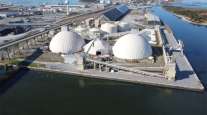Senior Reporter
Petroleum Institute Chief Economist Optimistic About Diesel Supply

[Stay on top of transportation news: Get TTNews in your inbox.]
WASHINGTON — The oil refining industry is ready for an upcoming mandate on the type of fuel to be used by the maritime industry, but shippers are scrambling to get ready as the deadline draws near, said the chief economist of the American Petroleum Institute.
“There are global precedents for what’s coming, and this is a regulation that has been in the works for more than 10 years. So, the refining industry has been preparing for it,” said API’s Dean Foreman at the American Trucking Associations annual Economic Summit conference, held Sept. 23.

Dean Foreman by Dan Ronan/Transport Topics
He was talking about an upcoming mandate from the International Maritime Organization, which takes effect Jan. 1, 2020, that outlaws the use of high-sulfur bunker fuel. The fuel is currently used on the open seas to power, for example, cargo and cruise ships. The mandate requires these and other ships to switch to low-sulfur diesel.
“The shipping industry is rushing to catch up and, as you might expect, they’re investing in scrubbers [and], to the extent they can, installing them,” Foreman said, referring to IMO-approved equipment that can be installed on ships to remove pollutants and get emissions to required levels.
While some shipping companies have said they will convert their fleets to liquefied natural gas, it is estimated by the U.S. Department of Energy and other sources that the shipping industry will need as much as 4 million barrels of low-sulfur diesel each day to replace bunker fuel.
Per the mandate, the maritime industry must decrease sulfur emissions from ships by lowering the sulfur content in marine fuel from 3.5% to 0.5% — seven times lower than it is now.
To meet the requirement, the majority of shipping companies are expected to significantly increase the use of diesel, or use new blends of fuel oil, which will be produced to meet the IMO limit. Bunker fuel has been used by the maritime industry for years — partly because of its lower cost — despite criticism about the level of pollutants.
The main type of bunker oil is derived as a residue from crude oil distillation. Crude oil contains sulfur which, after combustion in the engine, ends up in ship emissions. In the atmosphere, sulfur oxides can lead to acid rain, which can harm crops, forests and aquatic species, and contribute to the acidification of the oceans, according to IMO.
Limiting SOx emissions from ships will improve air quality and protect the environment, the group said.
A March report from the U.S. Energy Information Agency said the mandate could push the price of diesel as much as 20 cents a gallon higher than it is today.
In the U.S., Foreman said the petroleum shipping and trucking industries have been working to develop a strategy to ensure there is enough fuel available for everyone.
“This is something that from a U.S. supply perspective should be quite manageable,” he said. “To the extent there have been opportunities to invest additional strategically in storage facilities, that has been happening.”
Plus, he noted that the U.S. domestic oil industry is booming. Earlier this month, American producers pumped 12.4 million barrels of oil in a day.
Excellent opening panel on industrial and factories feat. @chadmoutray of @ShopFloorNAM, @RDeanForeman1 of @APIenergy and Emily Sanchez of @AmChemistry. #ATAeconsum19 pic.twitter.com/oEg6xZlUKN — American Trucking (@TRUCKINGdotORG) September 23, 2019
According to DOE, that figure has steadily increased since September 2016, when domestic production totaled about 8.4 million barrels per day.
“The revolution in U.S. production has shifted this,” Foreman said. “Even in 2014, just five years ago, we had $100-a-barrel oil. Just having cut that down to $56 a barrel for West Texas Intermediate oil — so there is a lot of stabilization.”
The conference took place as climate protesters shut down streets at 14 spots around Washington, including one near the event’s host hotel.
Foreman addressed the protests when discussing an EIA report that forecasts that 78% of the world’s energy requirements in 2040 will still come from fossil fuels. He noted that even as the U.S. and other nations work to reduce emissions, countries such as China and India are utilizing more coal.
WANT MORE NEWS? Listen to today's Daily Briefing
“We can protest, but let’s have a real dialogue on how we reduce emissions,” he said. “We also have to have a discussion about what it costs to get there, how we pay for it. There are no easy solutions, but just a recognition we are doing what we can to reduce emissions.”




